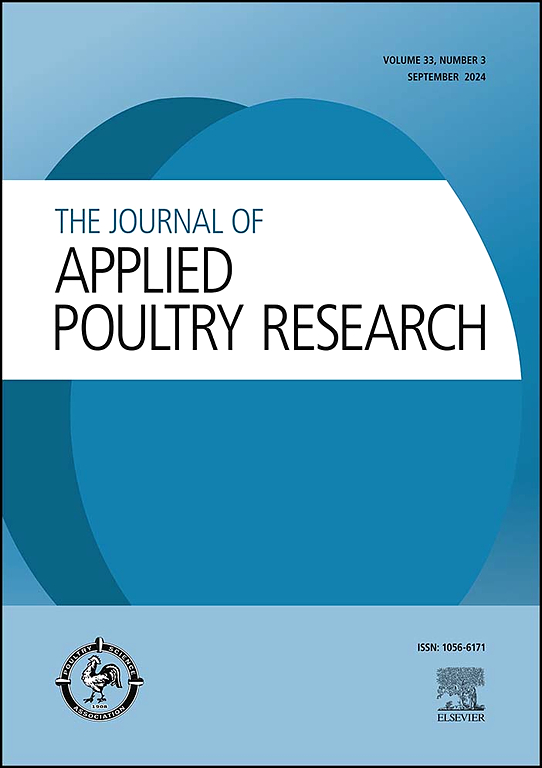Comparison of haemosporidian infection between wild red junglefowls and domestic chickens
IF 2
3区 农林科学
Q2 AGRICULTURE, DAIRY & ANIMAL SCIENCE
引用次数: 0
Abstract
Parasitic infections, including avian chronic haemosporidian infection, have been proven to be a major selection force affecting birds on a global scale including closely related bird species. To date, there has been limited information about haemosporidian infections in the red junglefowl (Gallus gallus) as compared to the domestic chicken (G. gallus domesticus). In this study, we collected blood samples of 39 wild red junglefowls and 122 domestic chickens to test for the presence of haemosporidian infections and various parasitic lineages. The PCR product of positive samples was sequenced, and their lineage was identified using the GenBank database. The result showed that all sampled red junglefowls tested positive for haemosporidian infection with 100% of parasite prevalence, while 104 domestic chickens tested positive (85%). Furthermore, parasite lineages were more diverse in red junglefowls compared to domestic chickens. We recommend that further research should be conducted on more populations of wild red junglefowls in comparison to the domestic chickens to ascertain the prevalence of haemosporidian parasites in association with vectors and other risk factors.
野生红丛林鸡与家鸡血孢子虫感染的比较
寄生虫感染,包括禽类慢性血孢子虫感染,已被证明是影响全球鸟类(包括近亲鸟类)的主要选择力量。迄今为止,与家鸡(G. gallus domesticus)相比,有关红色丛林鸡(Gallus gallus)血孢子虫感染的信息十分有限。在这项研究中,我们采集了 39 只野生赤麻鸡和 122 只家鸡的血液样本,以检测是否存在血孢子虫感染和各种寄生虫系。我们对阳性样本的 PCR 产物进行了测序,并利用 GenBank 数据库确定了它们的寄生虫系。结果显示,所有采样的红丛林鸡都对血孢子虫感染呈阳性,寄生虫感染率为 100%,而 104 只家鸡(85%)对血孢子虫感染呈阳性。此外,与家鸡相比,红丛林鸡体内的寄生虫品系更加多样化。我们建议,与家鸡相比,应对更多的野生红丛林鸡进行进一步研究,以确定血孢子虫寄生虫的流行与病媒和其他风险因素的关系。
本文章由计算机程序翻译,如有差异,请以英文原文为准。
求助全文
约1分钟内获得全文
求助全文
来源期刊

Journal of Applied Poultry Research
农林科学-奶制品与动物科学
CiteScore
4.10
自引率
10.50%
发文量
80
审稿时长
104 days
期刊介绍:
The Journal of Applied Poultry Research (JAPR) publishes original research reports, field reports, and reviews on breeding, hatching, health and disease, layer management, meat bird processing and products, meat bird management, microbiology, food safety, nutrition, environment, sanitation, welfare, and economics. As of January 2020, JAPR will become an Open Access journal with no subscription charges, meaning authors who publish here can make their research immediately, permanently, and freely accessible worldwide while retaining copyright to their work. Papers submitted for publication after October 1, 2019 will be published as Open Access papers.
The readers of JAPR are in education, extension, industry, and government, including research, teaching, administration, veterinary medicine, management, production, quality assurance, product development, and technical services. Nutritionists, breeder flock supervisors, production managers, microbiologists, laboratory personnel, food safety and sanitation managers, poultry processing managers, feed manufacturers, and egg producers use JAPR to keep up with current applied poultry research.
 求助内容:
求助内容: 应助结果提醒方式:
应助结果提醒方式:


